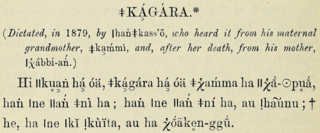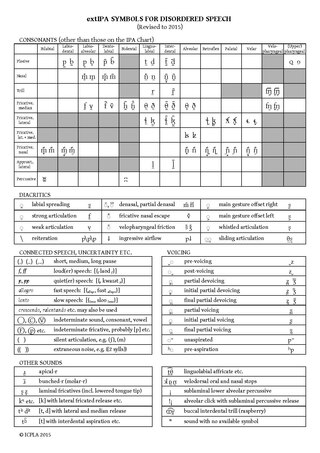
A diacritic is a glyph added to a letter or to a basic glyph. The term derives from the Ancient Greek διακριτικός, from διακρίνω. The word diacritic is a noun, though it is sometimes used in an attributive sense, whereas diacritical is only an adjective. Some diacritics, such as the acute ( ◌́ ), grave ( ◌̀ ), and circumflex ( ◌̂ ), are often called accents. Diacritics may appear above or below a letter or in some other position such as within the letter or between two letters.
E, or e, is the fifth letter and the second vowel letter in the Latin alphabet, used in the modern English alphabet, the alphabets of other western European languages and others worldwide. Its name in English is e ; plural es, Es or E's. It is the most commonly used letter in many languages, including Czech, Danish, Dutch, English, French, German, Hungarian, Latin, Latvian, Norwegian, Spanish, and Swedish.

The International Phonetic Alphabet (IPA) is an alphabetic system of phonetic notation based primarily on the Latin script. It was devised by the International Phonetic Association in the late 19th century as a standardized representation of speech sounds in written form. The IPA is used by lexicographers, foreign language students and teachers, linguists, speech–language pathologists, singers, actors, constructed language creators, and translators.

The Standard Alphabet is a Latin-script alphabet developed by Karl Richard Lepsius. Lepsius initially used it to transcribe Egyptian hieroglyphs in his Denkmäler aus Ägypten und Äthiopien and extended it to write African languages, published in 1853, 1854 and 1855, and in a revised edition in 1863. The alphabet was comprehensive but was not used much as it contained a lot of diacritic marks and was difficult to read and typeset at that time. It was, however, influential in later projects such as Ellis's Paleotype, and diacritics such as the acute accent for palatalization, under-dot for retroflex, underline for Arabic emphatics, and the click letters continue in modern use.
The African reference alphabet is any of several proposed guidelines for the creation of Latin alphabets for African languages. The initial proposals were made at a 1978 UNESCO-organized conference held in Niamey, Niger, based on the results of several earlier conferences on the harmonization of the Latin alphabets of individual languages, with a substantial overhaul proposed in 1982. None have official standing. The 1978 conference recommended the use of single letters for speech sounds instead of two-letter or three-letter sequences, or of letters with diacritics.
Americanist phonetic notation, also known as the North American Phonetic Alphabet (NAPA), the Americanist Phonetic Alphabet or the American Phonetic Alphabet (APA), is a system of phonetic notation originally developed by European and American anthropologists and language scientists for the phonetic and phonemic transcription of indigenous languages of the Americas and for languages of Europe. It is still commonly used by linguists working on, among others, Slavic, Uralic, Semitic languages and for the languages of the Caucasus, of India, and of much of Africa; however, Uralists commonly use a variant known as the Uralic Phonetic Alphabet.

The International Phonetic Alphabet was created soon after the International Phonetic Association was established in the late 19th century. It was intended as an international system of phonetic transcription for oral languages, originally for pedagogical purposes. The Association was established in Paris in 1886 by French and British language teachers led by Paul Passy. The prototype of the alphabet appeared in Phonetic Teachers' Association (1888b). The Association based their alphabet upon the Romic alphabet of Henry Sweet, which in turn was based on the Phonotypic Alphabet of Isaac Pitman and the Palæotype of Alexander John Ellis.
Unicode has subscripted and superscripted versions of a number of characters including a full set of Arabic numerals. These characters allow any polynomial, chemical and certain other equations to be represented in plain text without using any form of markup like HTML or TeX.
The Uralic Phonetic Alphabet (UPA) or Finno-Ugric transcription system is a phonetic transcription or notational system used predominantly for the transcription and reconstruction of Uralic languages. It was first published in 1901 by Eemil Nestor Setälä, a Finnish linguist.

The Extensions to the International Phonetic Alphabet for Disordered Speech, commonly abbreviated extIPA, are a set of letters and diacritics devised by the International Clinical Phonetics and Linguistics Association to augment the International Phonetic Alphabet for the phonetic transcription of disordered speech. Some of the symbols are used for transcribing features of normal speech in IPA transcription, and are accepted as such by the International Phonetic Association.
The International Phonetic Alphabet (IPA) requires specific names for the symbols and diacritics used in the alphabet.
Unicode supports several phonetic scripts and notations through its existing scripts and the addition of extra blocks with phonetic characters. These phonetic characters are derived from an existing script, usually Latin, Greek or Cyrillic. Apart from the International Phonetic Alphabet (IPA), extensions to the IPA and obsolete and nonstandard IPA symbols, these blocks also contain characters from the Uralic Phonetic Alphabet and the Americanist Phonetic Alphabet.
Tone letters are letters that represent the tones of a language, most commonly in languages with contour tones.
The tie is a symbol in the shape of an arc similar to a large breve, used in Greek, phonetic alphabets, and Z notation. It can be used between two characters with spacing as punctuation, non-spacing as a diacritic, or (underneath) as a proofreading mark. It can be above or below, and reversed. Its forms are called tie, double breve, enotikon or papyrological hyphen, ligature tie, and undertie.

English Braille, also known as Grade 2 Braille, is the braille alphabet used for English. It consists of around 250 letters (phonograms), numerals, punctuation, formatting marks, contractions, and abbreviations (logograms). Some English Braille letters, such as ⠡⟨ch⟩, correspond to more than one letter in print.

The umlaut is the diacritical mark used to indicate in writing the result of the historical sound shift due to which former back vowels are now pronounced as front vowels.
Luxembourgish Braille is the braille alphabet of the Luxembourgish language. It is very close to French Braille, but uses eight-dot cells, with the extra pair of dots at the bottom of each cell to indicate capitalization and accent marks. It is the only eight-dot alphabet listed in UNESCO (2013). Children start off with the older six-dot script, then switch to eight-dot cells when they start primary school and learn the numbers.

Dania is the traditional linguistic transcription system used in Denmark to describe the Danish language. It was invented by Danish linguist Otto Jespersen and published in 1890 in the Dania, Tidsskrift for folkemål og folkeminder magazine from which the system was named.
The Phonetic Symbol Guide is a book by Geoffrey Pullum and William Ladusaw that explains the histories and uses of the symbols of various phonetic transcription conventions. It was published in 1986, with a second edition in 1996, by the University of Chicago Press. Symbols include letters and diacritics of the International Phonetic Alphabet and Americanist phonetic notation, though not of the Uralic Phonetic Alphabet. The Guide was consulted by the International Phonetic Association when they established names and numerical codes for the International Phonetic Alphabet and was the basis for the characters of the TIPA set of phonetic fonts.







